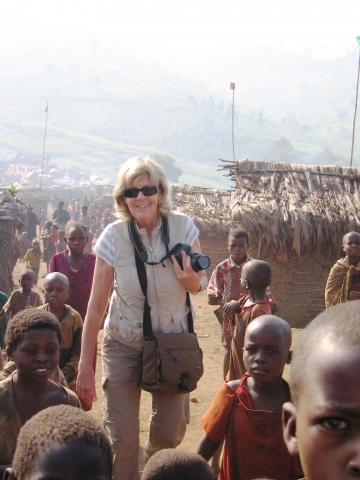Mir lecture series presents Sally Armstrong
After having witnessed the horrors that conflict thrusts upon innocent victims in some of the most unstable nations of the world for more than two decades, Sally Armstrong manages to stay incredibly optimistic.
One of Canada’s foremost journalists, Armstrong has covered women and girls in zones of conflict from Bosnia and Somalia to the Middle East, Rwanda, Congo and Afghanistan. An award-winning author and human rights activist, Armstrong’s work over the last 25 years has earned her the Order of Canada.
On Saturday, March 29 at Nelson’s Capitol Theatre, Armstrong will present The Ascent of Women: Progress Towards Gender Justice as part Mir Centre for Peace Lecture Series.
“I will be talking about how the Earth has shifted under the status of women,” Armstrong says. “I’m a journalist, I work in zones of conflict and have been doing it for 25 years. Basically I haven’t had a very good news story to tell because my beat is to find out what happens to women and girls in these places. About three years ago I started to think that the Earth was shifting under the status of women. At first I worried it was wishful thinking on my part, but then I did the research and found out I was right. I wanted to be the first one to report on that.”
Armstrong is currently on a book tour in the United States where she is talking about her latest project Ascent of Women: Our Turn, Our Way – A Remarkable Story of World-Wide Change.
Gym Teacher Turned War Correspondent
Armstrong was a high school gym teacher when she made the transition to a career in journalism. She was involved in the inception of what would become the magazine Canadian Living and in 1988 became the editor-in-chief of Homemakers magazine.
The shift was not as unusual as it may appear. Armstrong also taught high school English and had a lifelong interest in telling the stories of others.
“From my generation we were not encouraged to do things other than teach, nurse or be a secretary,” she says. “I think it was my way of rebelling to be a gym teacher and I loved it. It’s served me well because I work in zones of conflict where I spend a lot of time hiding in a shelled out building with 30 children who are scared out of their wits. I know 300 games, so it serves me well to be an ex-gym teacher in a war zone.”
Much More than Housekeeping Tips and Cooking Suggestions
In the early-1990s, Homemakers magazine was considered the thinking women’s magazine in Canadian publishing. At that time it faced stiff competition from Canadian Living and Chatelaine magazine. With the rise of all-news networks with the world’s strife arriving to Canadian homes more steady than ever, Armstrong felt she needed to take the magazine to the next level and bring the serious issue of how women are treated in war zones to Homemakers’ readers.
In 1992 Armstrong was in Sarajevo covering the Bosnian War when she started to hear rumours about rape camps.
“As journalists we know that one of the first casualties of war is invariably the truth,” Armstrong says. “I thought that this has to be a casualty of war and cannot be happening.”
Armstrong started digging and what she found out was extremely disturbing. Women and children were being rounded up and brought to rape camps. It’s estimated that 20,000 females from eight to 80 were victims of the horrible crimes during the war.
Feeling the issue was beyond the scope of Homemakers, Armstrong returned to Canada with her files of research and passed it off to one of Canada’s leading news agencies. Knowing this was an issue that had gone unreported, she told the editor to give the information and contacts to a reporter. After seven weeks the story still hadn’t appeared and when Armstrong called the editor he told her he had “forgot.”
Armstrong sat down with her team at Homemakers and it was decided that they would tell the story.
“Little Homemakers magazine broke the story,” she says. “Not because we were so smart, but because nobody wanted it. I thought if nobody wants to talk about what’s happening to women in these zones of conflict, I’m going to talk about it. That’s how I started doing war reporting.”
Making an Impact, Making a Change
For more than two decades Armstrong has carried forward her mission to bring the stories of women and girls to the Canadian public and to people from around the world. Her work is extensive and impressive, capturing accolades and changing minds.
It hasn’t always been easy and at times she has put everything on the line to get the story out. Her crusade to change the lives of impoverished and uneducated women in Afghanistan raised the ire of the ruthless Taliban and landed Armstrong on a list few would want to see their name.
“The Taliban are about 2,000 illiterate thugs with six guys who read,” Armstrong says. “And the six guys who can read put up a website when the Taliban were in power between 1996 and 2001. At one point on their website they made a list of people who had to be eliminated. Number-one on the list was George W. Bush, the president of the United States of America. It had other people with their names and their titles and their country… it was pretty fancy stuff. Number 11 on the list was the big woman from Canada with the yellow hair. I’m still mad at that, it was my chance to be famous and they didn’t even use my name.”
Though she jokes, Armstrong understands the danger she has put herself in over the years to bring these terrible stories to light.
“It’s difficult and it is scary sometimes, but these are incredible stories and you can’t help but feel humbled that the people are telling you what is going on,” says Armstrong. “Your job is make sure you get the truth and to get it out there. They are huge stories and stories that play in the back of my eyelids when I get home, but I feel really lucky that I’m the one that gets to tell them.”
Reasons to Feel Hopeful
A quarter century of work has come to this point and Armstrong feels optimistic about what the future holds for women and girls in conflict zones.
“You would like to think that finally the world woke up and decided to obey the law or be fair to women… that’s not true,” she says. “What’s happened is that the economists started to say that the status of women and the economy are directly related. When one flourishes so does the other, when one is in the ditch so is the other. People started shifting their view of the status of women in terms of the economy. At the very same time changes started to take place all over the world.”
One of the key figures in change is Malala Yousafzai, the young Pakistani girl who was shot by the Taliban because she wanted to go to school. Her story has become a world inspiration and Armstrong dedicated her most recent book to Malala.
“Even a few years ago we wouldn’t have heard the Malala story, but the opposite happened,” says Armstrong. “Her story was everywhere and every time she moved she was back in the paper. Malala became the world’s daughter and that is the epitome of what is going on in the world today. It affects everything we do, it affects the level of poverty, it affects the level of violence, it affects conflict and it affects the economy.”
Armstrong says another important tool for change is that the women’s movement across the globe has been united because of technology.
“What happened was Facebook… and that is when we had liftoff,” she says. “At that point the women around the world started to talk to each other. That was probably the worst day in the lives of misogynists, extremists and fundamentalists. We have traction now and I think it’s amazing.”
Armstrong continues to travel to the frontlines of conflict to tell stories. Although she is humble and won’t take any credit, Armstrong’s work over the years has contributed to the change she speaks about. Armstrong says what keeps her going is the passion she gets from living with the women she has reported on over the years and returning to see their lives changed.
“I love my job… I really love it,” she says. “It’s kind of like you want to get the end… I want to see how the story ends.”
Tickets for the Sally Armstrong Mir Centre for Peace Lecture Series are available at the Selkirk College Bookstore in Castlegar, Otter Books in Nelson or at the door. The talk begins at 7 p.m. on March 29 at the Capitol Theatre in Nelson.

























Comments